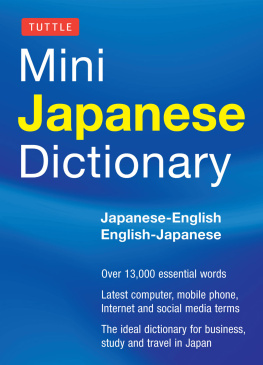basicJapanese Learn to Speak Everyday Japanese in 10 Carefully Structured Lessons SAMUEL E. MARTIN & ERIKO SATO About This BookBasic Japanese introduces the structure of Japanese through authentic, commonly heard Japanese sentences, useful contemporary Japanese vocabulary, and natural conversation. This book is particularly suited for those who wish to quickly build their knowledge of sentence structures and their communicative skills in Japanese. Each lesson starts with a section of Basic Sentences, which offers ten to twenty sentences serving as typical examples of essential sentence structures. These structures are explained thoroughly in the Structure Notes section later in the lesson. Basic Vocabulary lists thematically sorted vocabulary words and phrases that are relevant to the contextual theme of the lesson.
About This BookBasic Japanese introduces the structure of Japanese through authentic, commonly heard Japanese sentences, useful contemporary Japanese vocabulary, and natural conversation. This book is particularly suited for those who wish to quickly build their knowledge of sentence structures and their communicative skills in Japanese. Each lesson starts with a section of Basic Sentences, which offers ten to twenty sentences serving as typical examples of essential sentence structures. These structures are explained thoroughly in the Structure Notes section later in the lesson. Basic Vocabulary lists thematically sorted vocabulary words and phrases that are relevant to the contextual theme of the lesson.
The thematic grouping of the vocabulary is to help learners make associations to contexts more easily. The Conversation section offers an authentic dialog, in which you can learn basic, everyday discourse devices, such as natural ways of responding and acknowledging as well as appropriate ways of ending sentences in the context. Exercises are provided to strengthen your understanding of the content of the lesson. is mainly on sound systems, and not many grammatical facts are covered. However, the subsequent lessons introduce gradually more complex structures and facts about usage, so one can start with simple sentence structures and eventually learn complex sentences including conditionals, passives, and causatives by the time all ten lessons have been completed. Basic Japanese is an extensive revision of Essential Japanese, by Samuel E.
Martin, first published in 1957 and long a standard text for learning Japanese. Although Samuel Martin passed away in 2010 and was unable to review and approve the new changes, Basic Japanese maintains all the exciting linguistic insights of Essential Japanese, while incorporating linguistic changes that have taken place over the past several decades in terms of structure, vocabulary, and socio-cultural norms that are essential for communication in Japan today. Furthermore, all Japanese sentences (except those embedded in the English paragraphs) are presented in both kana/kanji and Romanization, and all sections except the Structure Notes and Exercise are recorded in the accompanying audio CD to help users learn the language as a whole. Illustrations, culture notes, and usage tips are provided in sidebars wherever they may help learners to put themselves in the communicative contexts. Here are some tips for getting the most out of Basic Japanese: The sentences in Basic Sentences are clearly laid out so that Japanese sentences can be seen from their English translations. Some items in each sentence are underlined, showing that they bear grammar/usage points that will be discussed in Structure Notes.
It is advisable that you not write down the answers in Exercises so you can use this section repeatedly for reviewing and reinforcing your understanding. Answers are provided in a smaller font after the questions. Many vocabulary words are presented outside of the Basic Vocabulary section, and you are advised to learn words from all the sections in each lesson. For example, Structure Note 3.1 lists relative time expressions such as ashita tomorrow, kin yesterday, raish next week, and kotoshi this year. Furthermore, all Japanese sentences except in Exercise are accompanied by English translations, so you can expand your vocabulary as you work through them. A glossary is provided at the end of the book for the learners convenience.
The authors are grateful to Cal Barksdale, Nancy Goh, Tan Cheng Har, and other editors and staff at Tuttle for their dedication and professionalism, as well as Akiko Saito for providing numerous illustrations, Taeko Kamei for her photographs, and Rui Tamura and Azuma Tanaka for helping to record the audio CD.  The Bonus Material from the Enclosed MP3 Audio CD may also be Downloaded. How to Download the Bonus Material of this Book. 1. You must have an internet connection. 2. http://www.tuttlepublishing.com/basic-japanese-downloadable-cd-content For support, you can email us at . About the Japanese Language The origins of the Japanese language are incompletely known, and multiple theories have been proposed over the past few centuries connecting Japanese to North Asian languages, South Asian Languages, and languages in other areas. About the Japanese Language The origins of the Japanese language are incompletely known, and multiple theories have been proposed over the past few centuries connecting Japanese to North Asian languages, South Asian Languages, and languages in other areas.
The Bonus Material from the Enclosed MP3 Audio CD may also be Downloaded. How to Download the Bonus Material of this Book. 1. You must have an internet connection. 2. http://www.tuttlepublishing.com/basic-japanese-downloadable-cd-content For support, you can email us at . About the Japanese Language The origins of the Japanese language are incompletely known, and multiple theories have been proposed over the past few centuries connecting Japanese to North Asian languages, South Asian Languages, and languages in other areas. About the Japanese Language The origins of the Japanese language are incompletely known, and multiple theories have been proposed over the past few centuries connecting Japanese to North Asian languages, South Asian Languages, and languages in other areas.
Currently, it is thought that the strongest theory among them is one of the North Asian ones, which places Japanese with Altaic languages such as Turkish and Mongolian based on the typological similarities, for example, sequential suffixation (agglutinating morphology), Subject-Object-Verb order, and vowel harmony in native vocabulary. Around the fourth and the fifth centuries AD, Chinese characters and vocabulary started to be brought to Japan. The Japanese developed manygana , in which a limited set of kanji were used to write Japanese words with their phonetic contribution. Eventually, in the Heian Period (7941185), hiragana and katakana were developed from some of the kanji characters included in manygana . Most content words, such as nouns, adjectives, and verbs, have a Chinese origin due to the strong influence of China in history. However, modern Japanese also includes an increasing number of loan words from English. The Japanese language is obviously extremely complex in terms of its lexicon and writing systems, but its unique structural features also surprise many speakers of English.
The following are only some of its unique features. Word order and particles The basic word order in English is subject-verb-object, whereas in Japanese it is subject-object-verb. The word order is rigid in English in most cases but can be very flexible in Japanese, so long as the verb is placed at the end of the sentence. For example, the English sentence Ken called Yumi can be either Ken-ga Yumi-o yonda or Yumi-o Ken-ga yonda in Japanese. Postpositions English prepositions such as from, in, on, at, and with correspond to postpositions in Japanese. Instead of saying from New York, they say something like New York from, or Ny Yku kara .
Japanese and English are mirror images in this respect. Dropping pronouns The Japanese are not lazy people, but they like to drop personal pronouns such as I, you, and he. The use of the second person pronoun anata you is almost forbidden in conversations. To ask, Is it yours? in speaking to Ms. Yamada, the Japanese will say, Sore wa Yamada-san no desu ka Ms. Yamada, is it Ms.
Yamadas? Verb morphology Japanese verbs and adjectives can be followed by numerous suffixes, one after another, just as if you are creating a necklace by putting beads together. For example, tabe is the shortest pronounceable form of the verb to eat. However, tabe-ru means will eat, tabe-sase-ru means will make someone eat, tabe-sase-rare-ru means will be made to eat, tabe-sase-rare-tai means want to be made to eat, and tabe-sase-rare-taku-nai means do not want to be made to eat. This feature of language is called agglutination, and it is one of the reasons many scholars think Japanese belongs to the Altaic language family.
Next page


















 About This BookBasic Japanese introduces the structure of Japanese through authentic, commonly heard Japanese sentences, useful contemporary Japanese vocabulary, and natural conversation. This book is particularly suited for those who wish to quickly build their knowledge of sentence structures and their communicative skills in Japanese. Each lesson starts with a section of Basic Sentences, which offers ten to twenty sentences serving as typical examples of essential sentence structures. These structures are explained thoroughly in the Structure Notes section later in the lesson. Basic Vocabulary lists thematically sorted vocabulary words and phrases that are relevant to the contextual theme of the lesson.
About This BookBasic Japanese introduces the structure of Japanese through authentic, commonly heard Japanese sentences, useful contemporary Japanese vocabulary, and natural conversation. This book is particularly suited for those who wish to quickly build their knowledge of sentence structures and their communicative skills in Japanese. Each lesson starts with a section of Basic Sentences, which offers ten to twenty sentences serving as typical examples of essential sentence structures. These structures are explained thoroughly in the Structure Notes section later in the lesson. Basic Vocabulary lists thematically sorted vocabulary words and phrases that are relevant to the contextual theme of the lesson. The Bonus Material from the Enclosed MP3 Audio CD may also be Downloaded. How to Download the Bonus Material of this Book. 1. You must have an internet connection. 2. http://www.tuttlepublishing.com/basic-japanese-downloadable-cd-content For support, you can email us at . About the Japanese Language The origins of the Japanese language are incompletely known, and multiple theories have been proposed over the past few centuries connecting Japanese to North Asian languages, South Asian Languages, and languages in other areas. About the Japanese Language The origins of the Japanese language are incompletely known, and multiple theories have been proposed over the past few centuries connecting Japanese to North Asian languages, South Asian Languages, and languages in other areas.
The Bonus Material from the Enclosed MP3 Audio CD may also be Downloaded. How to Download the Bonus Material of this Book. 1. You must have an internet connection. 2. http://www.tuttlepublishing.com/basic-japanese-downloadable-cd-content For support, you can email us at . About the Japanese Language The origins of the Japanese language are incompletely known, and multiple theories have been proposed over the past few centuries connecting Japanese to North Asian languages, South Asian Languages, and languages in other areas. About the Japanese Language The origins of the Japanese language are incompletely known, and multiple theories have been proposed over the past few centuries connecting Japanese to North Asian languages, South Asian Languages, and languages in other areas.